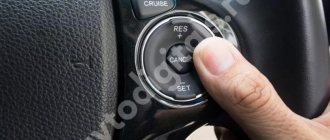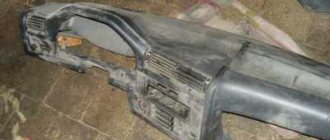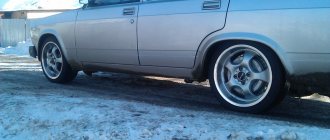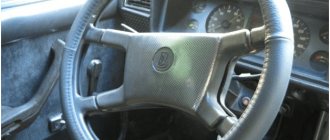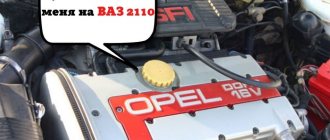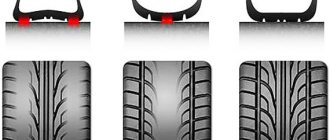The development of the modern automotive industry makes significant adjustments to the very style of driving a vehicle. Knowledge of the rules of the road, full control over the situation, following clearly established rules - all this makes up the workday of any motorist, and is a mandatory set of attributes of any trip behind the wheel. But the change of generations and the bright mind of the developers made it possible to escape from all these nuances for a certain time, while being on the road. The introduction of cruise control systems into vehicles of different segments and quality is not a surprise to anyone now. However, how does manual cruise control work, and is such a combination even possible if it is not provided by the factory set? Let's try to figure this out together.
General information
To understand how cruise control works on a manual transmission, it is worth familiarizing yourself with the features of its operation in more detail and at least approximately knowing the structure of such complex electronics.
Cruise control is designed to maintain a constant vehicle speed without driver intervention.
In other words, the driver will not have to put his foot on the pedals again to adjust the speed and constantly ensure that the car does not lose speed on the highway.
Many claim that cruise control, as such, is a useless system and not so necessary on modern cars. The main argument in such a debate is that many cars in the recent past a priori did not have such an option even in the maximum configuration, and only a certain and fairly narrow range of premium models were equipped with the coveted set of keys on the steering column lever.
However, in a certain number of cases it will be quite easy to do without this option. To understand whether it makes sense to purchase an option package that includes cruise control, it is worth understanding where the car is most often driven.
If the car spends most of its time in the city, being pushed around in traffic jams and driving at variable speeds, there is no point in cruise control. Otherwise, you will have to constantly “play” with the controls and thereby constantly load the already sensitive and expensive electronics.
Things are completely different if the driver constantly needs to move along the highway, away from cities. For example, long-term driving on a flat, straight road requires constant effort applied to the accelerator pedal. If the driver constantly keeps his leg in the same position, it will quickly get tired and go numb. To prevent this from happening, you just need to activate the desired button, and the leg can be immediately released.
Types of cruise control
The passive type system is a simple device that is designed to maintain a given speed. The system includes sensors, a control unit, and a throttle valve actuator.
The mechanism of operation of passive cruise control is very simple. When the speed reaches the optimal level, in the driver's opinion, he activates the system. ECU sensors remember speed and throttle position. If road conditions change (for example, the car is moving downhill or uphill), the sensors notify the ECU, and the control unit sends a signal to the throttle actuator. To maintain a stable speed, the actuator must open or close the valve. Active cruise control is most often called adaptive cruise control.
What does cruise control consist of, what are the principles of its operation?
Nowadays there are passive as well as adaptive cruise control systems. Passive ones consist of the following: control keys, auto controller, servo drive, as well as solenoid valves so that it can be controlled, and a drive for the throttle valve.
The manifold controls the servo valves, responding to differences in actual and target speeds. The servo drive uses the resulting vacuum, sending a signal from its membrane that controls the throttle valve, thereby correcting the fuel supply. This is how the set speed of the car is maintained regardless of changes in the route - descent or ascent.
For the sake of safety, the system is inactive if you drive slower than forty km/h, and cannot be turned on forcibly, and when you press the brake, it turns off.
Operating principle of passive cruise control
The simplest system for maintaining cruising speed includes the following main elements:
- vacuum or electric drive for turning the throttle valve with a cable;
- electronic control unit;
- set of sensors;
- control buttons located on the steering column switch or directly on the steering wheel.
Note. The number and type of sensors depends on the specific brand of car. Typically the kit includes a speed meter and limit switches for the brake and clutch pedals.
The controller, operating independently of the main engine control unit, is installed under the dashboard. The drive connected to the ECU is located next to the throttle valve and is connected to it by a cable. Cruise control on “mechanics” works according to the following algorithm:
- The driver accelerates the car to cruising speed, turns on the automatic and releases the accelerator pedal.
- The controller remembers the speed value and sends a command to the drive, which opens the throttle to the required angle.
- When driving uphill, the sensor records the deceleration of the car and transmits information to the control unit. The ECU forces the drive to open the throttle more, the fuel supply increases and the car maintains its original speed.
- On a descent, the picture is the opposite - the throttle closes as the car accelerates downhill.
- If the driver accelerates or decelerates the vehicle using the buttons, the damper is rotated by the drive through a small angle.
On a manual transmission, the effect of cruise control is limited to the speed range of one gear. If for some reason (for example, a steep hill) the car slows down to 30–40 km/h, the system is automatically deactivated. The electronics operate in a similar way when pressing the clutch and changing gears, so the driver has to constantly resume its operation.
With an automatic transmission, using cruise control is much more convenient. Since the automatic transmission changes gears depending on the oil pressure in the torque converter, that is, on engine speed, switching occurs automatically during acceleration or deceleration of the car. Robotic boxes equipped with an electric drive receive a request to engage the next gear from the controller.
On vehicles equipped with an electronic gas pedal, the throttle is initially controlled by a vacuum or electric drive. After activating the mode, the ECU takes over control of the drive mechanism and maintains the course speed.
Instructions for use
As you know, cruise control is the prerogative of a car that operates with an automatic transmission. Indeed, in a car with an automatic transmission it will be much easier to operate with cruise control - just press the gas pedal, accelerate your car to the required speed and lock the speed limit using a button on the steering column or dashboard.
However, no matter how surprising it may sound, there are a number of models on the market with manual transmission that also have cruise control. Mechanically, such a system has several features, expressed in the nuances of its use while traveling.
How to use cruise control? How does it work, and what do you need to know about such systems? Let's figure it out.
Typically, the cruise control control panel is located on the steering column stalk, which also controls the lighting or windshield wiper blades. The main controls are two switches with a two-way operating principle. They can be tilted left or right, depending on what needs to be activated.
The first switch is the cruise control lever. It should be moved from one extreme position to another, the system will be activated and will be ready to work in the specified mode. Immediately, the corresponding indicator lights up on the car’s on-board computer, and on the dashboard there is an icon depicting a speedometer with a limited scale. It is often possible to use the same key to reset the established speed readings and deactivate the system.
Another switch is an adjustment of the operating mode and a key for fixing the current speed. So, on cars with a manual transmission, you need to select the desired gear, accelerate the car and press the lock button. The current speed will be displayed on the dashboard, and the car will maintain it automatically without driver assistance.
If for some reason it is necessary to adjust the speed, and the cruise control is already activated, then there is no need to reset the current readings and accelerate or brake the car yourself. It is enough to move the switch up or down, which is responsible for fixing the current speed. In this case, on the dashboard, the fixed speed value will change up or down, and the car will instantly accelerate to the set value.
A peculiarity of the operation of cruise control on cars with manual transmission is the inability of the system to change gears independently. In other words, when adjusting the speed, you will have to select the gear yourself, and when accelerating, control the transmission manually: otherwise, there are no differences from automatic transmission systems.
"Toyota": installing cruise control yourself
Many people are interested in how to install cruise control on a Toyota.
The process itself is not that complicated. The main thing is to adhere to a clear sequence of actions. In case of difficulties, you can always contact a specialist. You will receive assistance from a professional auto repair shop.
What tools will you need if you install cruise control yourself?
To install the device, prepare:
- curved screwdriver;
- T25 star screwdriver;
- keys, namely, number 19;
- scissors and an awl with pointed ends;
- a lever that controls the device modes (suitable for modifying your car);
- a new steering wheel trim panel equipped with an additional slot for the control lever;
- a set of screws of the required size.
In what cases is its use justified?
The installation and use of a cruise control system on vehicles with a manual gearbox is justified in the following situations:
- the vehicle is operated on flat (in the geographical sense) terrain;
- vehicle operation involves long trips on high-quality highways with low and medium traffic intensity;
- speed on the highway is at least 60 kilometers/hour (this allows you to save fuel in high, constantly engaged gears).
Activation
Cruise control is activated when the expected cruising speed is reached. If the speed limit is set to 60 kilometers/hour on the selected section of the route, the highest gear or the one preceding it is set, depending on the power and torque of the engine, as well as the model of the manual gearbox.
If the car has a diesel engine, which has better torque characteristics at low engine speeds, it is advisable to install a higher gear. In this case, a more economical driving mode will be provided.
Gasoline engines require high revs to achieve acceptable torque characteristics, so at medium speeds it is better to set the second to last gear. For example, if there are five of them in a manual transmission, then when driving at cruising speed, 4th gear is set.
When activating the cruise control mode at speeds above 80 km/h, it is advisable that the maximum gear is engaged. The exception is when the car has a manual transmission with 6 or more gears.
Shutdown
In cars with automatic transmission, cruise control is deactivated when you press the accelerator or brake pedal in automatic mode. A similar arrangement for turning it off can be used in systems with manual transmission. Considering the peculiarities of using manual cruise control, the clutch pedal, an additional shutdown button, or pressing the activation button again can also be used.
Video - how to install cruise control on a manual (Mitsubishi Lancer X):
How the adaptive version works
Advanced electronic systems are installed on cars equipped with an automatic transmission or CVT. In addition to the elements listed above, adaptive cruise control involves an ultrasonic radar, a brake drive and several additional sensors mounted in the car’s body parts.
How active cruise control works:
- At a certain speed exceeding 40–50 km/h (the exact value depends on the make and model of the car), the driver activates the automation and releases the gas pedal. You need to perform an additional action - set the distance to the obstacle or the car moving in front using a separate key. The number is reflected on the display of the on-board computer.
- When the radar detects an approach to a vehicle, the ECU closes the throttle and slows down, and then adjusts to the speed of the object, maintaining the set distance.
- If the front car brakes, the electronics will stop the car. To move away, the driver needs to press the accelerator or press the appropriate key.
- If the vehicle ahead veers off the road, cruise control will accelerate your car to the initially set speed.
The system will respond to a stationary obstacle by braking until it comes to a complete stop. You must understand that simply turning on the cruise is not enough control; you need to monitor the road situation yourself . The radar coverage range is 150–200 m and at high speed this distance may not be enough for braking. When approaching a static obstacle, the driver must take control.
In business class cars and above, adaptive cruise control is often combined with other useful systems - recognition of road markings and signs, collision avoidance and automatic high beam control.
Install and connect the steering column switch
Required
- steering column switch (article 1119-3709340-20)
- Steering column switch connector (part number AMP 174922-1)
- terminals to the dashboard connector (part number AMP 963715-1)
Installation
:
- Remove the steering column cover (unscrew the fastening screws from the bottom and side).
- Squeeze the clamp and remove the standard steering column switch.
- Install a new steering column switch with buttons. Connection
- Remove the instrument panel
- Connect the new steering column switch to the dashboard (green -> 23 panel pin, red -> 24, yellow -> 10, black -> “ground”)
On Standard configuration
: Do the first start of the dashboard with a test (press the daily mileage reset button and turn on the ignition), the cruise control and speed limiter indicators should light up.
How to use cruise control. General leadership
The standard cruise control system has 5 control buttons mounted on the steering wheel.
- “On”—manual activation of the system;
- “Off” - manually turn off the system;
- “SetAccel” - setting and increasing the controlled speed value;
- “Resume” - restoration of the previously set speed value;
- “Coast”—reducing the controlled speed value;
In addition, the system is additionally controlled from the brake pedal.
Before using cruise control, you need to familiarize yourself with the purpose of the controls and operating modes of the control system.
The main operating mode switch or control panel has at the end a system activation key, indicated by a characteristic symbol or the inscription CRUISE and ON/OFF. The system can be activated when the vehicle speed exceeds 40 km/h.
The control system has the following operating modes
- The “SET” (S) mode allows you to set a controlled speed and set the automatic tracking mode;
- You can change the set speed upwards using the “ACCEL” mode (+; A).
- You can reduce the set speed using the “COAST” mode (–; C).
- You can restore the previous value of the set speed after a change using the “RESUME” (RES; R) mode.
- The “CANCEL” mode allows you to exit the set speed tracking mode.
Instructions for using cruise control modes
- When the vehicle speed is from 40 to 100 km/h, by briefly pressing the switch to the SET position, you can switch the system to automatic tracking and speed control mode.
- By holding the switch in the COAS position in auto-follow mode, you can reduce the driving speed, and you can set a new value after releasing the switch. By pressing briefly, the speed can be reduced by 1.5 km/h.
- To forcefully exit the mode of automatically maintaining the set speed, press the CANCEL key.
How to enable and disable cruise control?
On most cars, the cruise control buttons are located either on the steering column or on the steering wheel.
Before turning cruise control into active mode, it is mandatory to perform a certain procedure:
Cruise control on
1). Turn on the system by pressing the buttons with the cruise control logo or with the inscription CRUISE and ON/OFF. At the same time, the white color control indicator on the dashboard should light up. We accelerate the car to the required speed (more than 40 km/h) and briefly press the switch to the SET (S) position. The system indicator on the instrument panel will turn green. This will activate the automatic tracking mode.
Cruise control activated
To increase the set speed, move the switch to the RES/+ (RES/ACC) position until the car reaches the desired speed.
To reduce the set speed, press and hold the switch in the (COAST/SET) position until the speed decreases to the desired value.
To disable the automatic speed control mode, press the keys with the disable icon or with the inscription CANCEL, the OFF buttons, pressing the brake pedal, moving the automatic transmission knob from position D to the neutral position. In addition, the automatic mode is also switched off during sudden accelerations above 1.5 m/s.
Tools and materials
Before installing the CC, be sure to check all components and safety systems of your machine for malfunctions. Otherwise, do not be surprised that the cruise does not turn on, or the car behaves inappropriately when trying to maintain the set speed.
The set of tools to perform such a task will consist of:
Installation Features
To successfully connect the multi-steering wheel to the Lada-Vest, you will need to additionally install a bracket and an accelerator cable. This will provide the ability to control the speed level of the vehicle. Installing cruise control also requires installing a button that will control the device. It is located under the deflector. Knowing these features is important for a successful installation.
Installation as optional equipment
To install cruise control, you can purchase a set of additional equipment. Various models are developed for many car brands.
Drivenge Lada Priora MT - a set of equipment optimized for installation on Lada Priora cars with a manual transmission. This device is certified by the manufacturer and has a warranty period of 3 years.
Drivenge Lada Priora MT has three preset modes:
- sport;
- drive;
- economy
There is no need to explain their purpose - everything is very clear. The cruise control is activated by pressing the button, and turned off by pressing the brake or clutch pedal or pressing the activation button again.
The main feature of the device is that there is no need to install additional mechanical devices. The block emulates the accelerator pedal. Essentially, the device works instead of the driver, automatically making a decision to increase or decrease the “gas”. The driver's right foot can rest until the time comes to press the brake when traffic is obstructed or the road situation changes.
Functionality:
- speed adjustment with discretization of 1 km/h using buttons;
- memory of the last set speed;
- automatic shutdown of cruise mode using the clutch or brake pedal;
- selection of booster pedal modes (sport-economy-drive);
- the ability to update software by connecting to a computer;
- saving user modes in eeprom.
The package includes:
- Control block;
- steering column controller;
- wires with special clips for connection to standard electrical wiring without stripping or soldering;
- clamps for fastening harnesses, electrical tape;
- installation and operating instructions.
Almost any car enthusiast can install additional equipment, even without special electrical installation skills.
The cost of such a kit starts from 7,000 rubles, installation – from 1,500.
More expensive kits are available for other car models. For example, Jet-Cruise Kia Soul MT (for cars younger than 2014) will cost from 11,000 rubles. Its kit includes a special key fob, with the help of which modes are programmed and activation is activated. To connect, just connect the device to the OBD2 connector and the gas pedal plug.
The device is certified and can be installed on warranty vehicles.
Video - how to install cruise control on a Ford Focus:
Cruise control: what is it?
Cruise control is an additional vehicle option, thanks to which the speed is maintained at a certain level. This function is used exclusively for long trips on country roads or highways. When driving in urban areas, this function is not used.
This is interesting! On domestically produced cars, the cruise control system began to be used relatively recently, and only on luxury trim levels. If the need arises, you can install it yourself, which is what many owners of Russian cars do.
The cruise control system functions as follows: the driver drives out of town onto the highway, after which he turns on the option to support a certain speed limit. Regardless of the road surface, the system will maintain the speed at a certain level. This allows the driver to take his foot off the gas pedal and not control the speed.
Appearance of the cruise control buttons located on the steering column switch
The system in question is not a new product at all, but it gained popularity in Russia not so long ago. In Western European countries, the use of cruise control is the norm, as the system eliminates driver fatigue during long journeys. This option is installed from the factory on cars with different types of engines and transmissions. If the system in question is not installed on the car from the factory, then this is not yet a reason to change the vehicle. You can install it yourself, and even a beginner can cope with this task.
The invention of the cruise control system occurs in the USA, where the device is extremely popular. Today, manufacturers from different countries are producing such a system: Germany, Japan, China and others. Translated from English, “Cruise Control” means “constant speed control.” However, in addition to controlling speed and reducing driver fatigue, this system has another significant advantage - fuel economy. Numerous studies among motorists have revealed that fuel savings correspond to values of up to 5-7%. This is another reason to equip your vehicle with cruise control.
Features of operation on manual transmission and automatic transmission
On vehicles with manual transmission and automatic transmission, the operating principle of cruise control is the same, with the exception of some points. These points lie in the number of functions performed by the devices. However, let’s look at the initial components of the device and its operating principle.
The design of the simplest cruise control consists of a servo drive, which is connected to the throttle control mechanism. It is the servo drive that is responsible for supplying a certain amount of the fuel mixture. A servo drive is a negative feedback product used when driving a vehicle with a manual transmission.
Cruise control servo drive responsible for fuel supply
The operating principle of the device is as follows:
- When the car is moving at a constant speed limit, the gas pedal is in one position.
- When cruise control is activated, the throttle position is memorized by the microprocessor module.
- If the car moves up, the speed will decrease if the position of the throttle remains unchanged.
- To balance the speed of the car to the set value, the microprocessor sends the appropriate command to the servo drive, after which the latter adjusts the position of the damper. At the same time, not only the speed will increase, but also the fuel consumption will increase.
- If the car is moving downhill, the speed will increase, so to level it out, the microprocessor will send a signal to the servo drive to reduce the fuel supply. To balance the vehicle speed, the system uses engine braking, and consumption is significantly reduced.
- To cancel the set speed, simply press the brake pedal.
To emergency disable the cruise control function, simply press the brake pedal.
The cruise control module analyzes the information received and also compares it with those specified by the driver. Based on information processing, a specific car control algorithm is created. Now let’s figure out what are the differences in the functioning of the cruise control system for cars with manual transmission and automatic transmission.
How does the mechanical system work?
When using the cruise control system on a car with a manual transmission, the sector stops at the limiter. To do this, the driver should change from high to low gear. In addition, with a manual transmission, the driver needs to independently press the brake pedal if the need arises.
On a car with a manual transmission, when driving uphill and with the cruise control option activated, the driver will need to switch to a lower speed. If you don’t switch to it when going up a steep climb, you simply won’t be able to overcome the obstacle. The same applies to the situation when a car goes down a hill. If you do not shift to a lower gear for engine braking, the engine will develop a high speed.
Video: cruise control on a Suzuki Grand Vitara with manual transmission
How does the automatic system work?
On “automatic”, with the cruise control option turned on, there is no need to switch, since the device is responsible for all actions. As soon as the car reaches the desired speed, the servo will fix the position of the damper. If an adaptive type system is installed on a vehicle with an automatic transmission, then the car braking occurs automatically.
IF YOU DON'T HAVE CRUISE CONTROL BUT YOU REALLY WANT IT
Not every car, even of foreign origin, is equipped with cruise control. Don't change the car because of this. You can solve the problem in two ways: buy a ready-made system or assemble the cruise control yourself. The first option will cost a hefty sum, and the second way to make your car more comfortable and safe will not cost much, but will make you seriously rack your brain. DIY cruise control is installed differently depending on the car model and its technical characteristics.
For example, in the case of the Mazda3, installation of CC is carried out only on models with two-liter engines. The reason lies in the type of throttle, which should be electrical and not mechanical, as is the case with 1.6-liter engines.
Owners of Renault Fluence and Megane3 will find it easier to install cruise control themselves. This system will work properly on a car of any configuration, even the type of transmission does not really matter. However, there is one nuance: if the instrument panel does not have indicators that display the operation of the transmission, then control will be carried out blindly. Such an inconvenience will not overshadow the advantages that CC hides.
You can install cruise control yourself by purchasing a ready-made mechanism or assembling it from scratch. This process is lengthy, complex and involves subtleties that are determined for each vehicle model individually. But KK is worth the time and racket.
To bet or not to bet?
There is no clear answer. For gadget lovers, the positive emotions from “cruises” and jetters will probably outweigh the negative from the high price and unsightly appearance. Obvious disadvantages include interference with the car’s control electronics, which neither the warranty, nor the service, nor the law welcomes.
We liked the Jet-cruise KH better: it is more expensive, but easier to install. And the location of the remote control in the cabin can be adjusted to your taste.
Do-it-yourself cruise control - ZR instructions
Installed - looked
If you do not have the proper skills to communicate with the electrical equipment of modern cars, it is better not to undertake the installation of such devices yourself. First of all, this applies to the Drivenge system: we spent more than two hours fiddling around. Jet-cruise KH was able to install in half the time.
Drivenge.
Quite a lot of fuss. Drivenge is an extensive system with many connectors that need to be connected in the depths under the front panel. You will have to drill the steering column housing to install the steering column stalk. This control looks somewhat clumsy: you can’t press it - it’s just a place for buttons! And the design is frail: the attachment to plastic cannot be any other way. And the wires in the connectors are rolled loosely - unreliably.
Jet-cruise KH.
Much easier to install. You can place the self-powered remote control on two common batteries in any convenient place - either under your left hand or under your right hand. A drill will only be needed when installing the indicator LED. You don’t have to drill anything at all if you remove the indicator through a suitable slot, which is what we did in the first experiments. It will do for a short time, but, in general, it’s a little undignified to do so.
Approximate price 8600 rub.
The device allows you to turn on cruise control both at the current and at the last set speed. Changing settings - using the gas pedal or buttons in increments of 1 km/h. Automatic shutdown - when you press the brake or clutch pedal. The operating range is from 20 to 160 km/h. The “booster pedal” function has three operating modes: “economy”, “dynamics”, “sport”. It is possible to maintain an increased crankshaft speed at idle, for example, to warm up the engine. In the “sport” mode, the pedal seems too sharp, but the “economy” mode was quite pleasant as a winter mode on snowy and slippery roads.
Approximate price 11,200 rubles.
There is an audible warning when the speed limit set by the owner is reached or exceeded. The installation step is 1 km/h. The operating range is from 40 to 150 km/h. Changing settings - using the gas pedal or buttons. Automatic shutdown - when you press the brake or clutch pedal. The self-powered jetter implements one of three modes: “speaker”, “economy” or “sport”.
04.04.2017
The simplest homemade cruise control
The simplest cruise control that can be easily installed even on an old carburetor car.
This homemade product is from the old, old times, when universal cruise control kits were not yet sold, and electronic throttles, where the cruise function is easily implemented in software, were not in use. Therefore, this design seriously smells of mothballs. Which, however, does not deprive it of its functionality. What if someone finds it useful?
If you need to increase the speed, for example, to overtake, then you accelerate, pressing the gas pedal as usual, and when the maneuver is completed, your foot is removed from the pedal and the car itself smoothly returns to the speed recorded using SPFS. If you need to slow down, you can start actively braking with the brake pedal or simply touch it to start gentle engine braking - depending on the circumstances. In any case, a short or long touch on the brake pedal causes a positive signal to be sent from the “frog” of the brake lights to the SPFS control unit, and even the shortest positive impulse deactivates the system - the cable fixation disappears, and the return spring of the throttle assembly returns the damper to the idle position , leading to the start of engine braking.
However, unlike real and full-fledged cruise control, the driving speed with the SPFS system turned on is the only one, selected during setup taking into account the driver’s preferences. It will not be possible to adjust it while driving. There is also no provision for automatic adaptation to the road terrain; the set speed will only be that way on a flat road, and ascents and descents will, alas, affect the movement accordingly. These are the disadvantages. The advantages, as promised, are the simplicity and low cost of the design.
"Mechanics" and cruise
Most often, cars with automatic transmissions are equipped with this function, although you can independently install cruise control on a manual transmission if this option is not provided by the automaker. In this case, you will have to change gears yourself.
A specialized company will also help you with tuning to install the cruise. Some organizations have universal systems prepared for installation. It is also possible to independently purchase electrical equipment. In this case, the car owner selects the most comfortable option for his vehicle, taking into account ergonomic features.
Let's explain how cruise control works on a manual, because there is some difference here from working on an automatic. When you press the clutch or brake pedal, it switches off automatically. The driver must shift the transmission to the desired gear and then reactivate the cruise control if necessary. The shutdown is also performed when the ignition is turned off, as is the speed settings reset.
Choosing the best car compressor for inflating tires
- shaped screwdriver;
- sharp scissors or awl;
- knife;
- suitable sized heads;
- strong wrenches;
- self-tapping screws or good screws;
- cable for connecting the system;
- universal QC equipment;
- special bracket.
The bracket is required if the car is equipped with a sensor that regulates the position of the pedal responsible for accelerating (gas pedal). Then the bracket is connected to it. But in some cases the cable is already included with the cruise control. Therefore, check the package, and then collect all the necessary additional tools and materials.
Features of operation
Those who have driven cars equipped with standard cruisers will most likely not be attracted to such products - they are not very convenient to use and look unrespectable. But if such toys are new to someone, they may well come in handy.
Isn’t it dangerous to drive with these devices if they suddenly fail? After all, we interfered with the standard electrical equipment, breaking some of the car’s control circuits... We checked that when the power from both systems is turned off, the ability to control the car remains. Therefore, the manufacturers of both devices did not violate the old principle of “do no harm.”
The remote control is not backlit - on a dark country road you will have to manipulate it by touch. The indication only works at the moment of operation.
|
The Jet-cruise KH system is controlled from a wireless remote control, which can be glued anywhere. |
Jetter and booster pedal
After installing such a device, the car, as a rule, begins to react differently to the gas pedal, without the characteristic delay. This immediate response creates the illusion of improved dynamics. It is clear that there is no real improvement and cannot be, since the gadget does not change the firmware of the “brains” of the motor. It only slightly changes the operating characteristics of the gas pedal: at the same accelerator position, more fuel is supplied to the engine, which is why it seems that the car drives easier and more dynamically. At the same time, the maximum speed and intensity of acceleration with the pedal pressed to the floor will not increase one iota. The same effect can be achieved without any jetters - just press the pedal harder. Note that such systems do not cause any harm to the engine - however, they do not bring any benefit.
When installing the Drivenge system, be prepared to attach this set of wires, connectors and blocks.
When installing the Drivenge system, be prepared to attach this set of wires, connectors and blocks.
Advantages and disadvantages of the system
The advantages of this device are obvious - reducing the load on the driver. This is especially important during long trips along the highway, lasting more than one hour. The driver's leg does not get tired, because the control unit automatically increases or decreases the fuel supply, so the speed does not change. However, this device is not without its drawbacks. Any malfunction in its operation can lead to an accident, because it independently regulates the fuel supply to the engine. Another drawback is that this device relaxes the driver, which causes his concentration to decrease. This can also lead to an accident.
How cruise control works and instructions for use
Cruise control is a special device that ensures the convenience of long trips, and short ones too. Thanks to it, the car maintains the same speed regardless of the quality of the road, and the driver doesn’t even need to pay special attention to it. In cities, due to the variable speed of cars, cruise control is, in general, useless. It can be very useful when traveling out of town or between cities. And in order for cruise control to be in demand and its importance to be appreciated, you need to travel a long distance. Of course, such a system is most important in countries like America - where the roads are long and of high quality.
When buying a used car, even a very luxurious one, you may not have information about all its functions. This is because when driving a car there is enough information about its main indicators, or because the documents for it are incomplete/lost.
The process of connecting cruise control to a manual transmission when it is not provided by the manufacturer
Before proceeding with the installation of cruise control, the car owner must make sure that all technical components of his “iron horse” are in working order, and also install good tires on the car. This is due to the fact that in the presence of such malfunctions it is very dangerous to allow the car to drive under automatic control. If everything is in order, the driver will not endanger himself by driving on cruise control.
What you will need for installation
To complete the work, it is important to prepare in advance:
- curved screwdriver;
- scissors or an awl (the main thing is that they are very sharp);
- knife;
- nut head;
- wrench;
- a set of self-tapping screws (screws can also be used);
- a cable for connecting to the accelerator (it can also be included with the device);
- universal cruise control.
IMPORTANT! If your car has an accelerator pedal position sensor, then you will need to purchase an additional bracket for it, which you will also have to install yourself.
Installation process
In general, the entire work of installing cruise control on the mechanics will take you no more than an hour, however, you should set aside time to check the operation, as well as eliminate possible malfunctions. In general, the work consists of the following sequential actions:
- Choosing a location for the new device. Often, car enthusiasts attach it near the fuel filter, which also allows you to connect the cruise control to the brake hose. You can choose another place for it, the main thing is that it is dry, and the cable from the accelerator can be freely connected to it (if there are strong bends in the cable, you will not be able to control the speed).
- We connect the second cable to the accelerator, but do not rush to cut it. First, install the bracket on the gas pedal position control sensor, and only then measure the required length of the cable and cut it. After this, the second end of the cable can be connected to the cruise control device.
- To connect cruise control to a car, you must first find the tachometer connection wires, to which you need to connect the new device. The green wire that comes from the cruise control control unit must be connected to the tachometer wire. The red wire of the device is intended for connection to brake lights.
- Install the cruise control activation/deactivation button. To connect it, we connect the gray double wire. For full operation of the button and device, be sure to stretch the ground that runs along the black wire.
- The cruise control control knob must be installed on the steering wheel of the car, for which it will have to be disassembled. If your car has airbags, they will also have to be removed for a while. We install the handle on the steering wheel and put it back together, not forgetting about the airbags.
IMPORTANT! If you cannot run the cable from the accelerator in such a way that there are no bends in it, you can use a regular fishing reel, along which it will bend freely without breaking or damaging other mechanisms of the car.
We check the operation of the cruise control. To do this, we recommend that you drive along an empty road where there is no traffic. It is rational to do a test activation of the device at low speed (but above 40 km/h), while being prepared for the need to control the accelerator pedal if the device suddenly does not work.
How to connect the system if the manufacturer did not provide it
First of all, you first need to make sure how good the car components are. Good tires must be installed. If these conditions are not met, the machine should not be allowed to operate automatically. If all systems are in working order, the driver will ensure his safety.
It is important to pay attention to the presence of a sensor that controls the location of the accelerator pedal. If there is one, you will need to purchase an additional bracket. You can also install it yourself.
Is it possible to do a cruise on your own?
When making a CC yourself, the following questions arise:
- where to get a diagram that does not need to be altered to fit your car;
- how to ensure overall system reliability;
- how to avoid mistakes that can lead to tragedy.
where to get a servo drive with suitable characteristics;
A large number of different diagrams taken from production cars of the end of the last century are posted on the Internet. Finding parts for them is problematic because they are no longer produced. If you use modern circuits with microcontrollers, then no one knows how such a circuit will behave during some kind of failure. Perhaps it will lower the engine speed to idle, or maybe it will sharply increase it to maximum. If this happens at a sharp turn, tragedy cannot be avoided. Another problem is the servo drive, the pitch of which is tenths of a millimeter. This will allow you to smoothly regulate the speed of the car and avoid jerking.
Many DIYers suggest using a motor and gearbox from windshield wipers for this, however, this option is not very good due to high inertia and difficulties with adjustment. If you use the electronic gas pedal drive from a damaged foreign car, then why not take the control unit from there? Installing such a drive on a car with a throttle cable will require installing and connecting a servo drive to the throttle valve. All this allows us to conclude that you can do cruise control yourself if you are well versed in electronics, have access to the component base and can carry out a serious modification of the car yourself.
What else do those who use cruise control need to know?
How to check an inactive system
If the activated cruise control on your car does not function or works poorly, you must first check if there are any problems with it. In this case, you need to act like this:
- Turn on the ignition;
- Press the ON button, which is located on the cruise control remote control. Then the CRUISE ENGAGED indicator light will light up. If for any reason it burns out, you need to insert a new, working one in its place;
- Press and hold Resume, releasing after three seconds;
- Then the light will first flash for three seconds and go out for two. Then, if there are problems, the light will show you the codes of the detected errors. And in the absence of these same problems, you need to reset the self-diagnosis mode. This is done this way:
- Pick up speed sixteen km/h;
- Disable cruise control by pressing the OFF button;
- Make sure that the indicator light no longer flashes.
- How can I read the error codes displayed by the indicator?
When reading error codes, you must remember the following:
- The codes are separated by a long pause;
- The numbers in the two-number codes are separated by a short pause.
For example: code 12 is indicated by a long flash, followed by first a short pause, and then a pair of short flashes.
How to respond to indicator signals that mean certain error codes:
Code 01
Here you should inspect the wiring that connects the system control panel, check the operation of the brake light switch, and also how well the system brake pressure sensor functions.
Code 05
In this case, you should check the fuse, as well as the wiring that connects the cruise control to the fuse.
Code 07
It is necessary to check the brake light switch, as well as the sensor that determines whether the system brake is pressed.

